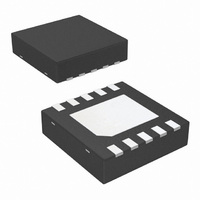LP5996SDX-2533/NOPB National Semiconductor, LP5996SDX-2533/NOPB Datasheet - Page 10

LP5996SDX-2533/NOPB
Manufacturer Part Number
LP5996SDX-2533/NOPB
Description
IC REG 300/150MA RF/ANLG 10LLP
Manufacturer
National Semiconductor
Datasheet
1.LP5996SD-2828EV.pdf
(14 pages)
Specifications of LP5996SDX-2533/NOPB
Regulator Topology
Positive Fixed
Voltage - Output
2.5V, 3.3V
Voltage - Input
2 ~ 6 V
Voltage - Dropout (typical)
0.11V @ 150mA, 0.21V @ 300mA
Number Of Regulators
2
Current - Output
150mA (Min), 300mA (Min)
Operating Temperature
-40°C ~ 85°C
Mounting Type
Surface Mount
Package / Case
10-LLP
Lead Free Status / RoHS Status
Lead free / RoHS Compliant
Current - Limit (min)
-
Other names
LP5996SDX-2533
www.national.com
Application Hints
OPERATION DESCRIPTION
The LP5996 is a low quiescent current, power management
IC, designed specifically for portable applications requiring
minimum board space and smallest components. The
LP5996 contains two independently selectable LDOs. The
first is capable of sourcing 150mA at outputs between 0.8V
and 3.3V. The second can source 300mA at an output voltage
of 0.8V to 3.3V.
INPUT CAPACITOR
An input capacitor is required for stability. It is recommended
that a 1.0µF capacitor be connected between the LP5996 in-
put pin and ground (this capacitance value may be increased
without limit).
This capacitor must be located a distance of not more than
1cm from the input pin and returned to a clean analogue
ground. Any good quality ceramic, tantalum, or film capacitor
may be used at the input.
Important: Tantalum capacitors can suffer catastrophic fail-
ures due to surge current when connected to a low-
impedance source of power (like a battery or a very large
capacitor). If a tantalum capacitor is used at the input, it must
be guaranteed by the manufacturer to have a surge current
rating sufficient for the application.
There are no requirements for the ESR (Equivalent Series
Resistance) on the input capacitor, but tolerance and tem-
perature coefficient must be considered when selecting the
capacitor to ensure the capacitance will remain approximately
1.0µF over the entire operating temperature range.
OUTPUT CAPACITOR
The LP5996 is designed specifically to work with very small
ceramic output capacitors. A 1.0µF ceramic capacitor (tem-
perature types Z5U, Y5V or X7R) with ESR between 5mΩ to
500mΩ, is suitable in the LP5996 application circuit.
For this device the output capacitor should be connected be-
tween the V
It is also possible to use tantalum or film capacitors at the
device output, C
for reasons of size and cost (see the section Capacitor Char-
acteristics).
The output capacitor must meet the requirement for the min-
imum value of capacitance and also have an ESR value that
is within the range 5mΩ to 500mΩ for stability.
NO-LOAD STABILITY
The LP5996 will remain stable and in regulation with no ex-
ternal load. This is an important consideration in some cir-
cuits, for example CMOS RAM keep-alive applications.
CAPACITOR CHARACTERISTICS
The LP5996 is designed to work with ceramic capacitors on
the output to take advantage of the benefits they offer. For
capacitance values in the range of 0.47µF to 4.7µF, ceramic
capacitors are the smallest, least expensive and have the
lowest ESR values, thus making them best for eliminating
high frequency noise. The ESR of a typical 1.0µF ceramic
capacitor is in the range of 20mΩ to 40mΩ, which easily
meets the ESR requirement for stability for the LP5996.
For both input and output capacitors, careful interpretation of
the capacitor specification is required to ensure correct device
operation. The capacitor value can change greatly, depend-
ing on the operating conditions and capacitor type.
OUT
pin and ground.
OUT
(or V
OUT
), but these are not as attractive
10
In particular, the output capacitor selection should take ac-
count of all the capacitor parameters, to ensure that the
specification is met within the application. The capacitance
can vary with DC bias conditions as well as temperature and
frequency of operation. Capacitor values will also show some
decrease over time due to aging. The capacitor parameters
are also dependant on the particular case size, with smaller
sizes giving poorer performance figures in general. As an ex-
ample, Figure 1 shows a typical graph comparing different
capacitor case sizes in a Capacitance vs. DC Bias plot. As
shown in the graph, increasing the DC Bias condition can re-
sult in the capacitance value falling below the minimum value
given in the recommended capacitor specifications table
(0.7µF in this case). Note that the graph shows the capaci-
tance out of spec for the 0402 case size capacitor at higher
bias voltages. It is therefore recommended that the capacitor
manufacturers’ specifications for the nominal value capacitor
are consulted for all conditions, as some capacitor sizes (e.g.
0402) may not be suitable in the actual application.
The capacitance value of ceramic capacitors varies with tem-
perature. The capacitor type X7R, which operates over a
temperature range of -55°C to +125°C, will only vary the ca-
pacitance to within ±15%. The capacitor type X5R has a
similar tolerance over a reduced temperature range of -55°C
to +85°C. Many large value ceramic capacitors, larger than
1µF are manufactured with Z5U or Y5V temperature charac-
teristics. Their capacitance can drop by more than 50% as the
temperature varies from 25°C to 85°C. Therefore X7R is rec-
ommended over Z5U and Y5V in applications where the
ambient temperature will change significantly above or below
25°C.
Tantalum capacitors are less desirable than ceramic for use
as output capacitors because they are more expensive when
comparing equivalent capacitance and voltage ratings in the
0.47µF to 4.7µF range.
Another important consideration is that tantalum capacitors
have higher ESR values than equivalent size ceramics. This
means that while it may be possible to find a tantalum capac-
itor with an ESR value within the stable range, it would have
to be larger in capacitance (which means bigger and more
costly) than a ceramic capacitor with the same ESR value. It
should also be noted that the ESR of a typical tantalum will
FIGURE 1. Graph Showing a Typical Variation in
Capacitance vs DC Bias
20171540











